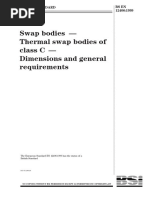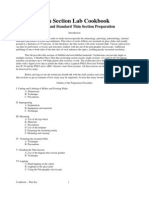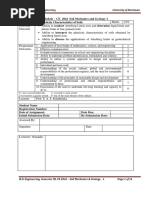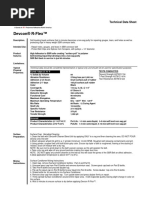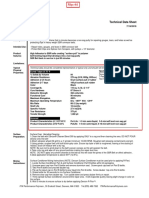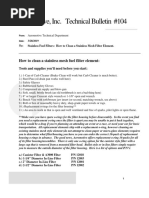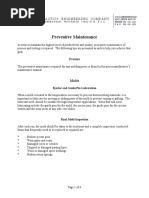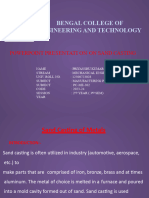Kayak Maintenance and Repair: Southern Nevada Paddling Club
Kayak Maintenance and Repair: Southern Nevada Paddling Club
Uploaded by
Scott NelsonCopyright:
Available Formats
Kayak Maintenance and Repair: Southern Nevada Paddling Club
Kayak Maintenance and Repair: Southern Nevada Paddling Club
Uploaded by
Scott NelsonOriginal Title
Copyright
Available Formats
Share this document
Did you find this document useful?
Is this content inappropriate?
Copyright:
Available Formats
Kayak Maintenance and Repair: Southern Nevada Paddling Club
Kayak Maintenance and Repair: Southern Nevada Paddling Club
Uploaded by
Scott NelsonCopyright:
Available Formats
KAYAK MAINTENANCE and REPAIR
I. Southern Nevada Paddling Club KAYAK INSPECTION Fiberglass, Kevlar and Plastic
opposite side of bulkhead or hull for water drops. Cockpit Coaming Cracks and chips. Hanging Seats 1. Elliptical screw holes. 2. Loose or worn screws. 3. Worn seat parts. Foot Braces and Rails loose screws and wear Deck Rigging weakness, wear, or damage General Hardware loose or damaged. Carrying Handles & Loops - wear or damage. Painters (Bowline) - wear or damage. The following should be fully inspected once each year. Visual inspection of all surface items every three months. A. Hatch covers Gaskets and rubber seals. B. Rudder Cables 1. Remove screws at cable ends inspect cable and screws for wear. 2. Check for frayed sections along cable length. C. Rudder Assembly - Remove Screws and inspect all parts for wear. D. Bulk Heads 1. Visual Loose or cracked caulking 2. Water leak test - pour 1 quart to gallon of water into section. Place kayak at an angle so water is against the bulkhead, then inspect
E. F.
G. H. I. J. K.
II.
KAYAK GENERAL MAINTENANCE - Fiberglass, Kevlar and Plastic
A. Hull Maintenance 1. Cleaning - Use a mild soap and water. 2. Hard water stains White vinegar and water solution, 30 percent vinegar to 70 percent water. Place solution in a spray bottle and apply on small area, wipe clean with paper towel or soft cloth. 3. Waxing/Polish Use a good quality marine Wax/Polish. 4. Ultraviolet (UV) protection spray deck and hull with 303 Protectant. This product is also good for spray skirts, PFDs and etc. 5. UV Hull Damage Use a rubbing compound to remove chalky surface. Then apply a Marine polish. Finish by applying a coat of 303 Protectant. B. General Maintenance 1. Clean Foot Pedal/Slide Bar Track with high-pressure hose. Wipe Track and slide bar with paper towel or cloth. Caution: metal parts may have sharp edges. Apply Tri-Flow or Super Lube dry lubricant on Foot Pedal/Slide Bar Track. 2. Clean cockpit interior with high-pressure hose. Remove all mud and small pebbles. 3. Every two to three trips lubricate rudder assembly.
III.
KAYAK GENERAL REPAIR - Fiberglass, Kevlar and Plastic
A. Bulkhead Caulking 1. Remove all old caulking (clean and repair one side at a time). Clean surface with scraper, sand paper, then alcohol. 2. Use 3M Marine Adhesive Sealant 5200, 10 fl oz. Use a caulking gun and apply in sections of approximately six to eight inches. Place kayak at a slight angle so adhesive flows towards bulkhead. Adhesive tends to cold flows, rotate hull to control direction of flow. When first section is stable complete caulking of the next section. This material takes approximately 48 hrs to completely cure. 3. When the first side has fully cured, then repair the opposite side of Bulkhead. B. Rudder Cables 1. Apply a light coating of Tri-Flow or Super Lube dry lubricant (do not use a silicone base lubricant), use a Q-tip or small rag, to areas of the cable that makes contact with metal parts or cable channels. C. Foot Pedal and Rails 1. Use masking tape and tape a double thick layer of paper towel on the hull under each end of the Foot Pedal/Slide Bar and Track. This will catch dirt and lubricant drops. Author: Milton D. Rasmussen Page 1 of 5 Revised: September 7, 2002
Recommended book for repair and Maintenance: The Essential Outdoor Gear Manual, Annie Getchell, Ragged Mountain Press.
KAYAK MAINTENANCE and REPAIR
Southern Nevada Paddling Club
2. 3. 4. 5. 6. 7. D. 1. 2. 3. 4. Remove Foot Pedal/Slide Bar from Track clean both with steel brush and/or stiff toothbrush. Wipe Track and slide bar with paper towel or cloth. Caution: metal parts may have sharp edges. Use emery paper or small mill file to remove sharp edges and burrs from Foot Pedal/Slide Bar and Track. Clean the Track groves with a dry Q-tip. Spray a Q-Tip with a small amount of Tri-Flow or Super Lube. Then wipe each grove in the Track. This will remove additional dirt from the Track. Do not spray Tri-Flow or Super Lube directly into the Track Spray the foot pedal/slide - back, front and edges with a thin film of Tri-Flow or Super Lube dry lubricant. Spread lubricant with a Q-Tip Insert Foot Pedal/Slide Bar into the Track. Move Foot Pedal/Slide Bar back-and-forth in theTrack to spread lubricant. Rudder Assembly Use a wrench and screwdriver to remove rudder from mount. Clean assembly parts. Use emery paper or small mill file to remove sharp edges and burrs from Rudder parts. Apply Tri-Flow or Super Lube dry lubricant to metal parts that make metal-to-metal contact. Replace all worn parts and screws. Then reassemble.
E. Hanging Seat 1. Remove seat and inspect screw holes. If holes are elliptical there are three methods for repair. a) First Clean and fill hole with an epoxy Place a washer on both sides, and then patch, then redrill the hole. install a screw through the center hole, b) Second - Drill a slightly larger hole and which will also hold the seat. insert a metal sleeve (spacer) of correct size c) Third -Drill a new mounting hole in a and length, with a hole through its center. different place if necessary. F. Hatch Covers 1. Cleaning - Use a mild soap and water to clean hatch cover and around lip of hatch (coaming). 2. Spray Armor All on all rubber or neoprene hatch covers parts (not on Kayak hull or deck). Wipe of excess with a paper towel or cloth.
IV.
1. 2. 3. 4. 5. 6.
REPAIR TOOLS AND MATERIALS
Masking tape, inch wide. Emery PaperMill File (fine tooth file) Q-Tips Screw Drivers, as required Wrenches, as required Tri-Flow (Sherwin-Williams) or Super Lube. (Synco Chemical Corp., www.super-lube.com) Sources: Hardware, Home Depot, and Auto Parts stores. 7. 3M Marine Adhesive Sealant 5200, 10 fl oz tube. (Source: Home Depot). 8. Caulking Gun 9. Armor All. Source: Auto part stores (Armor All Products, Irvine, CA). 10. 303 Protectant (303 Protectant Inc. Paleo Cedro, CA). Source: Home Depot. 11. Rubber Gloves.
V.
GENERAL KAYAK REPAIRS - Fiberglass and Kevlar
This section is limited to Gelcoat repairs (surface and cosmetic) and will not cover extensive repair of hull penetration or fracture of Fiberglass or Kevlar materials. It is recommended that the manufacturer repair hull penetration damage.
A. Kayak Hull Repair Fiberglass and Kevlar
Gelcoat repair can be accomplished with a minimum of materials and tools. It does however require that specific procedures be followed. The following material can be used in surface repair of Gelcoat.
Author: Milton D. Rasmussen
Page 2 of 5
Revised: September 7, 2002
Recommended book for repair and Maintenance: The Essential Outdoor Gear Manual, Annie Getchell, Ragged Mountain Press.
KAYAK MAINTENANCE and REPAIR
Southern Nevada Paddling Club
1. Kits and Repair Materials A. Epoxy Patch Kit (select one type) a) Evercoat Marine Match and Patch, Gelcoat Repair Kit, No. 668. Source: West Marine. Includes 6 color pigments. b) Sea Fit, Gelcoat Repair Kit, SEAFI No. 105192 (model # 140251). Source: West Marine. Includes 6 color pigments. c) Marine-Tex, Mfg: Travaco. Trvco # 133884 (model # 140251). Source: West Marine plus Marine and Auto Parts stores. Note: Long term tests have proven this to be a short-term repair. Material tends to flake away after several months. Most repair kits come with instructions for mixing the epoxy resin and hardener (catalyst) use rubber gloves when handling materials. Follow the health warnings, these materials can cause skin and eye irritation plus respiratory irritation. B. 1. 2. 3. 4. 5. 6. 2. A. B. Repair Materials Squeegee Sandpaper, 320, 380, 400, 600-grit. Backing pad for sandpaper Rubbing compound Clear plastic sheet - approx. 2 to 3 mil thick Masking tape, or 1 inch wide. 7. Spatula (Ice cream stick), for mixing and applying material. 8. Alcohol, Denatured 9. Plastic coffee can lid or similar material. For a mixing dish 10. Rubber Gloves.
Gelcoat Repair Surface Preparation Remove any cracked or flaking gel coat material. Lightly sand repair area to remove fading and oxidized materials. Bevel edge of scratch or gouge to improve adhesion of repair epoxy patch. Clean the patch area with Denatured Alcohol. Be careful not to touch work area with bare hands. Epoxy and Color Test Use a plastic coffee can lid or similar plastic piece to mix epoxy material on. Place a suitable amount of epoxy and hardener on plastic surface and mix. Be sure to completely mix all material. Separate the mixed epoxy material into three equal parts. a) Apply the colored pigment onto one sample section. Add pigment until color match appears to be correct and of the recommended amount. Mix completely. Spread out one edge of the sample until it is thin. Clean spatula. b) On the second test sample section apply approximately 20 percent more pigment than the first test sample. Mix completely. Spread out one edge of the sample until it is thin. Clean spatula c) Leave the out the third sample section without any pigment. Allow all test samples to cure. Every few minutes test the surface of all epoxy samples for the following: a) The usable work time. The point where the material can not be applied or spread. b) The cure time. Where the material is hard and can be sanded or polished. After the samples have completely cured. Check manufactures recommendation. a) Check the unpigmented sample for hardness and flexibility. It should be hard and brittle. b) The first pigmented test sample should also be hard and brittle. You may find that the color sample may have very little color in the thin section of the sample. c) The second pigmented test sample should also be hard and brittle (sample may be slightly more flexible than fists sample). You will find that this color sample will have improved color density in the thin section of the sample. If the sample is soft and flexible then there is too much pigment or not enough hardener in the epoxy. Select the best sample for use in the final repair.
C. Epoxy Hull Repair After you have identified the epoxy mix and color ratio; mix a suitable amount of material to perform the hull repair. Do not mix too large of an epoxy batch for use. Note: a large batch of mixed epoxy generates heat, reduce work time, Author: Milton D. Rasmussen Page 3 of 5 Revised: September 7, 2002
Recommended book for repair and Maintenance: The Essential Outdoor Gear Manual, Annie Getchell, Ragged Mountain Press.
KAYAK MAINTENANCE and REPAIR
Southern Nevada Paddling Club
and in very large batches can burn. You will have approximately 5 to 10 minutes to complete all work before the epoxy starts to setup. Work in very small repair sections. Large section may not give you enough time to complete all required work. Apply a thin layer of epoxy into the damaged area that is to be repaired. Place a clear thin plastic sheet over the epoxy patch material. Spread the epoxy material that is under the plastic sheet with a squeegee. Run the squeegee along the line of the scratch or at a 45-degree angle, not across the scratch. Use masking tape to hold down the plastic sheet until epoxy has cured. A small sandbag (approx. 1 lb.) may be place over the plastic sheet to provide equal pressure across the repair surface. Leave until the epoxy has cured. D. Patch Finish Caution: avoid breathing the sanding dust. Peel off the plastic sheet. If required sand patch area using 320 to 380-grit paper with a backing pad. Next sand with 400-grit paper and backing pad to remove scratches.
Finally sand with 600-grit paper with backing pad. Use rubbing compound to finish surface. Polish as needed.
E. Repair Through Holes in Deck Use a 60-degree screw camber tool on the front and backside of hole. Do not go very deep. Note: This will help to conceal the repair and prevent the repair plug from moving. Place a piece of masking tape on the underside of the hole. Make sure that epoxy will not flow through the patch. Inject material in to the hole until full. Perform epoxy repair as described in the above article. Finish the top surface as described in the above article. The surface underneath only requires the removal of any sharp edges.
VI.
A. 1. 2. 3. 4. 5. 6.
KAYAK TIPS - Fiberglass and Kevlar
Storage Tips Store kayak in garage or under a cover to reduce Ultra Violet (UV) damage to kayak hull and deck rigging. When storing the kayak - remove all hatch covers to dry out the compartments. Place kayak on a form fitting hull cradle or suspend on web belts, 1 to 2 inches wide. Place cradle or belts at or near Bulkhead area. This is the strongest area of the hull. Storing kayaks on one side of hull also works well. Release all tie down belts, lines or life lines that may put stress on deck fittings, which may cause stress cracks in jell coat. If the rudder has an elastic pull down line, lower the rudder during storage to reduce damage to elastic line.
B. Transport Tips 1. Do not tighten holding straps excessively. This can cause Gelcoat cracking and excessive pressure on fabric lamination can cause material to delaminate. 2. Use a bowline tied to car bumper or other car parts to reduce bow lifting. On long kayaks also use a stern line to prevent kayak rocking and reduce hull damage. Also on long trips use a stern line on all kayaks. 3. When carrying more than one kayak tie a line between the kayaks, both bow and stern, this reduces rotation by side wind thrusts. 4. Stow all handles and deck line ends to prevent damage to kayak deck. Wind may cause banging of parts on the deck surface. 5. Lock down the rudder in the stowed position to prevent vibration during transport.
VII.
KAYAK HULL REPAIR Polyethylene Plastic
This section is also limited to surface repair and maintenance of plastic hulls. Hull penetration repairs should be performed by the manufacture. Author: Milton D. Rasmussen Page 4 of 5 Revised: September 7, 2002
Recommended book for repair and Maintenance: The Essential Outdoor Gear Manual, Annie Getchell, Ragged Mountain Press.
KAYAK MAINTENANCE and REPAIR
Southern Nevada Paddling Club
A. Hull Surface Blemishes Removal of surface blemishes such as plastic hairs and scratch ridges these can be removed by a safety razor or small wood plane. B. Hull Deformation 1. Hull Dents - Remove hull dents by heating area with a heat lamp or hair dryer gun, then press on inside of hull to return hull to original shape. Caution: do not over heat hull surface. A small beanbag or sandbag placed on inside of dented area while heating outside of hull also works. 2. Hogged Remove reversed hull curve (Hogged Hull) by hanging kayak by its carrying handles or on wood blocks with hull side down. Works best during hot summer days. Adding a five-pound sandbag inside may help.
VIII. KAYAK TIPS - Polyethylene Plastic
A. Storage and Tips 1. Store kayak in garage or under a cover to reduce UV damage to hull and deck rigging. 2. When storing kayak remove all hatch covers to dry out the compartments. 3. Place kayak on a form fitting hull cradle or suspend on web belts, 1 to 2 inches wide. Place cradle or belts at or near Bulkhead area. 4. Storing kayaks on side of hull or on deck for plastic boats, reduces hogging and denting of hull. 5. Manufactures often store plastic kayaks by standing them on end. B. 1. 2. 3. 4. 5. Transport Tips Do not tighten holding straps excessively. This can deform the hull and change Tracking, especially in summer. Do not leave plastic kayak tied tightly on car tops for long periods during summer days. This may deform the hull. Use a bowline tied to car bumper or other car part to reduce bow lifting. On long kayaks also use a stern line to prevent kayak rocking, this can reduce hull damage. Also on long trips use a stern line on all kayaks. When carrying more than one kayak tie a line between the kayaks, both bow and stern, this reduces rotation by side wind thrusts. Do not pull down excessively on lines, which may cause hogging.
IX.
1. 2.
FIELD EMERGENCY REPAIR - Fiberglass, Kevlar and Plastic
Pierced Hull Duct Tape or Epoxy putty stick on inside and outside of hull. Rudder Cable breakage Several methods. a) Splice short section of cable into rudder cable using material from emergency kit. b) Use a short piece of rope to join broke cable. c) Replace the broken cable using material from emergency kit. Rudder Assembly Use Nuts and bolts from emergency kit.
3.
X. EMERGENCY REPAIR KIT 1. 3M Duct Tape, type 131 (1.88 in wide by 10 yd.) and Epoxy stick or putty (Primex of California, Ding Stick Kit). 2. Alcohol swabs - individually prepackaged 3. Spare screws, washers nuts and bolts1. 4. Screw drivers Phillips and common blades, as required for your kayak. 5. Vice-grip pliers and common pliers 6. Multitool knife 7. Spare rudder cable and swages. 8. Rudder Cable cutting tool. 9. Bungee cord 10. Galvanized wire
1
11. Adjustable wrenches or set of open-end wrenches, as required for your kayak. 12. Rope, or 3/8 inch, 20 ft long. 13. Sand Paper 320 or 380 grit 14. Sharp Knife.
Select size and type to fit your specific kayak. Author: Milton D. Rasmussen Page 5 of 5
Revised: September 7, 2002
Recommended book for repair and Maintenance: The Essential Outdoor Gear Manual, Annie Getchell, Ragged Mountain Press.
You might also like
- Titanic Instructions 11312 11315 11318 11320Document40 pagesTitanic Instructions 11312 11315 11318 11320Thiago LimaNo ratings yet
- EuroPro 6130 Sewing Machine Instruction ManualDocument57 pagesEuroPro 6130 Sewing Machine Instruction ManualiliiexpugnansNo ratings yet
- Cooling Fan Wiring DiagramDocument4 pagesCooling Fan Wiring DiagramJosh Frikas80% (5)
- 84in 1 A5Document6 pages84in 1 A5tnuagNo ratings yet
- Bending ShapesDocument4 pagesBending ShapesramjoceNo ratings yet
- BS en 12406-1999Document18 pagesBS en 12406-1999DoicielNo ratings yet
- Michael W. Pelphrey: A Best Practice Guide To Avoiding Program Failure Traps While Tuning System PerformanceDocument374 pagesMichael W. Pelphrey: A Best Practice Guide To Avoiding Program Failure Traps While Tuning System PerformanceGeorge BaciuNo ratings yet
- Chapter 12Document35 pagesChapter 12bilbilak50% (2)
- Carbon Fibre Fishing Pole Repair Kit InstructionsDocument4 pagesCarbon Fibre Fishing Pole Repair Kit InstructionsdaveagriffNo ratings yet
- Impression Tech in FPDDocument51 pagesImpression Tech in FPDDrGagandeep Singh100% (3)
- Epoxy Fiberglass Pipe Wrap Directions: SnopsisDocument4 pagesEpoxy Fiberglass Pipe Wrap Directions: SnopsisdroidsNo ratings yet
- L11-Sample Preparation For TEMDocument38 pagesL11-Sample Preparation For TEMSyAsya DoliExiaNo ratings yet
- Thin Section CookbookDocument5 pagesThin Section CookbookTara QuitiLen OngNo ratings yet
- A Cheap Sensitive Hydrophone For Monitoring CetaceanDocument4 pagesA Cheap Sensitive Hydrophone For Monitoring CetaceanAmador Garcia IIINo ratings yet
- Preventive Maintenance - PFDocument6 pagesPreventive Maintenance - PFAnurag SrivastavaNo ratings yet
- Build Great Models 3Document3 pagesBuild Great Models 3Earl PattersonNo ratings yet
- Impression Materials and Impression Techniques: ClassificationDocument7 pagesImpression Materials and Impression Techniques: ClassificationruchikaNo ratings yet
- Carbon Fibre Skinning Starter KitDocument8 pagesCarbon Fibre Skinning Starter KitcraigbonnymanNo ratings yet
- Introduction To 8 Inc Pressure VesselsDocument23 pagesIntroduction To 8 Inc Pressure VesselsAckmonNo ratings yet
- Tex 600JDocument44 pagesTex 600JLucio Rodriguez SifuentesNo ratings yet
- 3 - Foundry&Casting - Shop 1Document9 pages3 - Foundry&Casting - Shop 1Mansi NegiNo ratings yet
- Fiber Optic CommunicationDocument15 pagesFiber Optic Communicationralphisaac212121No ratings yet
- ObjectDocument77 pagesObjectامير بشير جوادNo ratings yet
- Kayak Maintenance and RepairDocument4 pagesKayak Maintenance and RepairlittelNo ratings yet
- Grains May Be Coarse or FineDocument8 pagesGrains May Be Coarse or FineAshok ChowdaryNo ratings yet
- Grains May Be Coarse or FineDocument8 pagesGrains May Be Coarse or FineAshok ChowdaryNo ratings yet
- Grout AlternatesDocument2 pagesGrout AlternatesAnonymous ua66zYwrpNo ratings yet
- JT 59 PDFDocument2 pagesJT 59 PDFAndone AnutuNo ratings yet
- Stainless Steel Feedlip Installation InstructionsDocument1 pageStainless Steel Feedlip Installation InstructionsJorge Mercado NajeraNo ratings yet
- Material Lab Manual Experiments January2016 1Document47 pagesMaterial Lab Manual Experiments January2016 1gosaye desalegn100% (2)
- NW Custom Guitars Conductive Shield Paint Kit Instructions 2017.Document4 pagesNW Custom Guitars Conductive Shield Paint Kit Instructions 2017.NWCustomGuitarsNo ratings yet
- CARB Deconstruction SOP 09/13/13Document7 pagesCARB Deconstruction SOP 09/13/13Chris HerzecaNo ratings yet
- Plasticity Characteristics of Soils-Lab SheetDocument14 pagesPlasticity Characteristics of Soils-Lab SheetAngel HasnaNo ratings yet
- Fission-Track Laboratory Procedures at Union College: John I. Garver, PH.DDocument48 pagesFission-Track Laboratory Procedures at Union College: John I. Garver, PH.DAlbanian GeologyNo ratings yet
- Sonolastic - NP2 - Polyutherane Caulking SealantDocument6 pagesSonolastic - NP2 - Polyutherane Caulking SealantOgbedande Awo Orunmila100% (1)
- Exp.3 Specimen PreparationDocument9 pagesExp.3 Specimen PreparationG. Dancer GhNo ratings yet
- Inspection Spark TestingDocument4 pagesInspection Spark TestingAshish PattanaikNo ratings yet
- TDS - R FlexDocument2 pagesTDS - R FlexDivyanshu GuptaNo ratings yet
- Teachers Guide - Concrete ProductionDocument12 pagesTeachers Guide - Concrete ProductionsateeshsinghNo ratings yet
- Fiber Optic Cable TerminationDocument16 pagesFiber Optic Cable TerminationStephenNo ratings yet
- Welcome To The World Os Scale ModelingDocument7 pagesWelcome To The World Os Scale Modelingnicomore3136100% (2)
- Amiantit. Field Installation ProcedureDocument37 pagesAmiantit. Field Installation ProcedureABAID ULLAHNo ratings yet
- Gutter RepairsDocument8 pagesGutter RepairsMuhammad RizwanNo ratings yet
- Impression Tech in FPDDocument50 pagesImpression Tech in FPDDrGagandeep SinghNo ratings yet
- SKC InhalableDocument12 pagesSKC InhalablehafickryNo ratings yet
- Oar Shaft CrackRepairDocument2 pagesOar Shaft CrackRepairLin LinNo ratings yet
- Impression in FPDDocument9 pagesImpression in FPDAmar Bhochhibhoya100% (1)
- Mục 64 Keo dán nguội băng tải Devcon R flex 15565Document2 pagesMục 64 Keo dán nguội băng tải Devcon R flex 15565Việt Hùng NghiêmNo ratings yet
- Laboratory Procedures: Record BasesDocument4 pagesLaboratory Procedures: Record BasesMohneesh DamadeNo ratings yet
- Impressions For FPDDocument53 pagesImpressions For FPDpragatiNo ratings yet
- Cu Electroforming TutorialDocument19 pagesCu Electroforming TutorialBruce Michael100% (1)
- Special Tray Fabrication & Final Impression: Name: Sara Aswad Aziz Group: EDocument13 pagesSpecial Tray Fabrication & Final Impression: Name: Sara Aswad Aziz Group: ELaween Abdulkhaliq100% (1)
- Maintenance Manual: Star Building SystemsDocument18 pagesMaintenance Manual: Star Building SystemsmuminiNo ratings yet
- Cor Coupon InstructionsDocument2 pagesCor Coupon InstructionsalkhiatNo ratings yet
- Rubber Lining ApplicationDocument9 pagesRubber Lining ApplicationeyslNo ratings yet
- Bottle RocketDocument24 pagesBottle RocketCarl AlbNo ratings yet
- Borbon PeTa #4Document4 pagesBorbon PeTa #4Borbon, Raphael Juan Jacinto O.No ratings yet
- Simulated Firearms Training Laser 8 StepsDocument23 pagesSimulated Firearms Training Laser 8 StepsArifDarmawanNo ratings yet
- Cleaning Stainless Filter Elements TB-104 - How To Clean A Stainless Mesh Filter Element.Document2 pagesCleaning Stainless Filter Elements TB-104 - How To Clean A Stainless Mesh Filter Element.yugihardiatnaNo ratings yet
- Worldwide Engineering Standards: Tape Adhesion Test For Paint FinishesDocument3 pagesWorldwide Engineering Standards: Tape Adhesion Test For Paint FinishesRicardo Bavasso100% (1)
- RT/duroid 5870/5880 High Frequency Laminates Fabrication GuidelinesDocument8 pagesRT/duroid 5870/5880 High Frequency Laminates Fabrication GuidelinesmaamriaNo ratings yet
- Sect 29 Preventive MaintenanceDocument6 pagesSect 29 Preventive MaintenancezfiyldvmNo ratings yet
- SR-71 Blackbird Rocket PlansDocument8 pagesSR-71 Blackbird Rocket PlansAviation/Space History LibraryNo ratings yet
- Naveen Kumar Sand Casting College Roll 237094034Document26 pagesNaveen Kumar Sand Casting College Roll 237094034BARUN SINGHNo ratings yet
- Top of Mind. Total Spontaneous Recall. Aided Recall. Distribution Knowledge. Advertising RecallDocument9 pagesTop of Mind. Total Spontaneous Recall. Aided Recall. Distribution Knowledge. Advertising RecallLaila RashedNo ratings yet
- An Interview With Gary HamelDocument8 pagesAn Interview With Gary HamelKaren CardenasNo ratings yet
- Management Theory and Organizational BehaviorDocument1 pageManagement Theory and Organizational BehaviorThaddi SrinivasNo ratings yet
- Budget Performance ReportsDocument3 pagesBudget Performance ReportsmaricelgjuicoNo ratings yet
- FOI 2021 541 NG DataDocument184 pagesFOI 2021 541 NG DataGeorge ChanNo ratings yet
- An Overview of Human Resource Management: MoneyDocument191 pagesAn Overview of Human Resource Management: Moneymelkamu endaleNo ratings yet
- Literacy in The Time of Artificial Intelligence 03apr24Document31 pagesLiteracy in The Time of Artificial Intelligence 03apr24pedagogo1.digitalNo ratings yet
- Radio HandbookDocument72 pagesRadio Handbookringbolt100% (4)
- School Managment SystemDocument20 pagesSchool Managment SystemMohammad ArslanNo ratings yet
- STAT CON (Latin Rules A-E)Document16 pagesSTAT CON (Latin Rules A-E)Kimberly Sendin0% (1)
- NodeJS Interview QuestionsDocument20 pagesNodeJS Interview QuestionsakshayNo ratings yet
- 105 01Document122 pages105 01wakeupatdawn4247No ratings yet
- A211 MA2 EXERCISE 4 (TOPIC 4 Performance Measurement) - Questions - Upoladed 18 Dec 2021Document3 pagesA211 MA2 EXERCISE 4 (TOPIC 4 Performance Measurement) - Questions - Upoladed 18 Dec 2021Amirul Hakim Nor AzmanNo ratings yet
- Web Services Developers GuideDocument84 pagesWeb Services Developers Guideallu_facebookNo ratings yet
- XEROX Phaser 6300, 6350, 6360 Parts List, Service ManualDocument564 pagesXEROX Phaser 6300, 6350, 6360 Parts List, Service ManualDaniel Christopher Hargett100% (1)
- 6565 12714 1 SMDocument19 pages6565 12714 1 SMdedeh srigayantiNo ratings yet
- Officer's Particulars: Musat Radu-StefanDocument7 pagesOfficer's Particulars: Musat Radu-StefanRadu M.No ratings yet
- Vda. de Esconde vs. CADocument6 pagesVda. de Esconde vs. CARubyNo ratings yet
- Mechanical Measurement and Metrology: Prepared by - Navroz NavodiaDocument20 pagesMechanical Measurement and Metrology: Prepared by - Navroz NavodiaengrodeNo ratings yet
- Job InterviewDocument3 pagesJob InterviewISIDRO JOSE MOLINA BUELVASNo ratings yet
- Service Manual For Chery QQ6: (Electrical, Circuit)Document37 pagesService Manual For Chery QQ6: (Electrical, Circuit)Leonard KevNo ratings yet
- Nathan Andrews CVDocument4 pagesNathan Andrews CVnathanandrewsNo ratings yet
- 1Document54 pages1Leandro AranedaNo ratings yet
- Parrish Et Al v. National Football League Players Incorporated - Document No. 176Document12 pagesParrish Et Al v. National Football League Players Incorporated - Document No. 176Justia.comNo ratings yet
- 11-23 Local 11 Letter To EEOC Concerning HMS HostDocument13 pages11-23 Local 11 Letter To EEOC Concerning HMS HostKTARNo ratings yet





